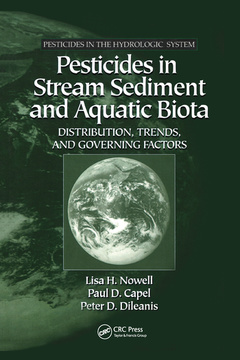Pesticides in Stream Sediment and Aquatic Biota Distribution, Trends, and Governing Factors
Auteur : Nowell Lisa H.

More than 20 years after the ban of DDT and other organochlorine pesticides, pesticides continue to be detected in air, rain, soil, surface water, bed sediment, and aquatic and terrestrial biota throughout the world. Recent research suggests that low levels of some of these pesticides may have the potential to affect the development, reproduction, and behavior of fish and wildlife, and possibly humans.
Pesticides in Stream Sediment and Aquatic Biota: Distribution, Trends, and Governing Factors assesses the occurrence and behavior of pesticides in bed sediment and aquatic biota-the two major compartments of the hydrologic system where organochlorine pesticides are most likely to accumulate. This book collects, for the first time, results from several hundred monitoring studies and field experiments, ranging in scope from individual sites to the entire nation. Comprehensive tables provide concise summaries of study locations, pesticides analyzed, and study outcomes.
Comprehensive and extensively illustrated, Pesticides in Stream Sediment and Aquatic Biota: Distribution, Trends, and Governing Factors evaluates the sources, environmental fate, geographic distribution, and long-term trends of pesticides in bed sediment and aquatic biota. The book focuses on organochlorine pesticides, but also assesses the potential for currently used pesticides to be found in bed sediment and aquatic biota. Topics covered in depth include the effect of land use on pesticide occurrence, mechanisms of pesticide uptake and accumulation by aquatic biota, and the environmental significance of observed levels of pesticides in stream sediment and aquatic biota.
Introduction
Purpose
Previous Reviews
Approach
Characteristics of Studies Reviewed
General Design Features
Geographic Distribution
Temporal Distribution
Sampling Matrices
Target Analytes
Analytical Detection Limits
National Distribution and Trends
Pesticide Occurrence
National Pesticide Use
Geographic Distribution in Relation to Use
Long-Term Trends
Governing Processes
Pesticide Sources
Behavior and Fate of Pesticides in Bed Sediment
Behavior and Fate of Pesticides in Aquatic Biota
Analysis of Key Topics - Sources, Behavior, and Transport
Effect of Land Use on Pesticide Contamination
Pesticide Uptake and Accumulation by Aquatic Biota
Seasonal Changes in Pesticide Residues
Physical and Chemical Properties of Pesticides in Sediment and Aquatic Biota
Composition of Total DDT as an Indicator of DDT Sources and Period of Use
Analysis of Key Topics - Environmental Significance
Effects of Pesticide Contaminants on Aquatic Organisms and Fish-Eating Wildlife
Effects of Pesticide Contaminants in Aquatic Biota on Human Health
Summary and Conclusion
Appendix A: Table 2.1 Pesticides in bed sediment and aquatic biota from rivers and estuaries in the United States: National and multistate monitoring studies
Appendix B: Table 2.2 Pesticides in bed sediment and aquatic biota from rivers in the United States: State and local monitoring studies
Appendix C: Table 2.3 Pesticides in bed sediment and aquatic biota from rivers in the United States: Process and matrix distribution studies
Appendix D: Common Names and Taxonomic Classifications of Aquatic Organisms Sampled in the Studies Reviewed
Appendix E: Glossary of Common and Chemical Names of Pesticides
References
Index
Date de parution : 06-2020
17.8x25.4 cm
Thème de Pesticides in Stream Sediment and Aquatic Biota :
Mots-clés :
Aquatic Biota; Organochlorine Insecticides; Insecticides; Total DDT; Biomonitoring; Bed Sediment; Rivers; FDA Action Level; Bed; Total Chlordane; Organochlorine; Heptachlor Epoxide; National; Total DDT Residue; Contaminant; Pesticide Analytes; Program; United States Rivers; United; NCBP; States; Farm Production Region; agricultural management practices; Total DDT Concentration; organochlorine pesticides; BSAF Value; hydrologic system; National Pesticide Monitoring Program; terrestrial biota; Toxaphene Concentration; National Academy; Lower Screening Values; Log BCF; Soil Half Life; Fugacity Ratio; Edible Fish Tissue; Contaminated Site; ISQG; Technical Chlordane
